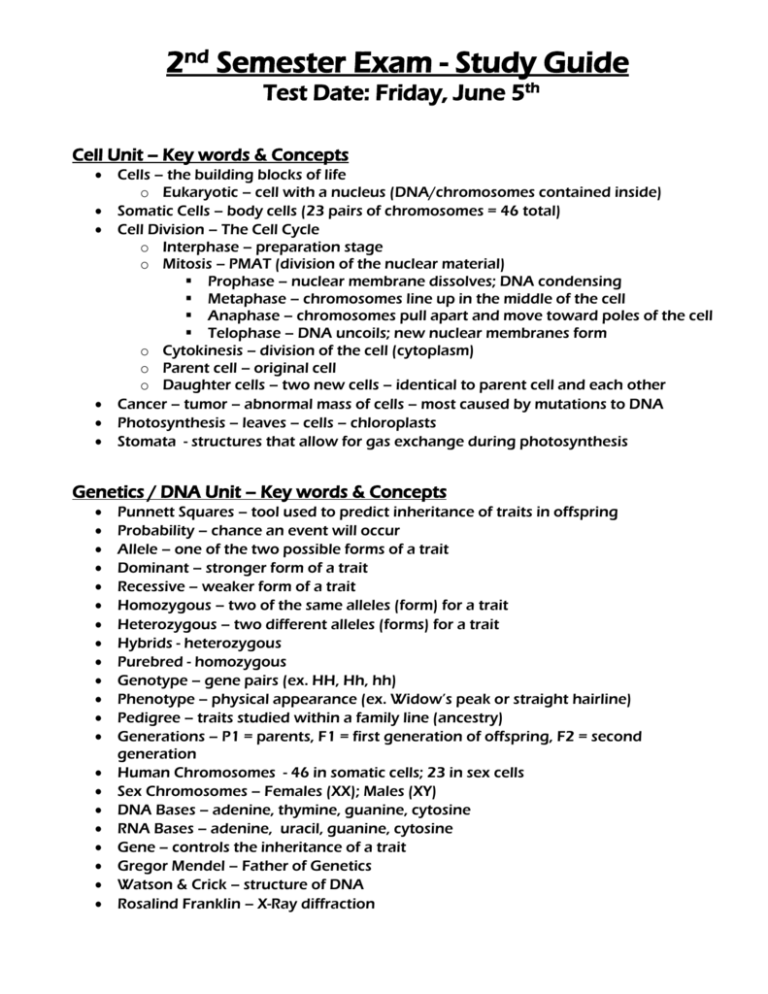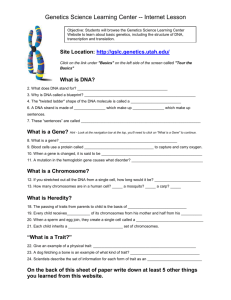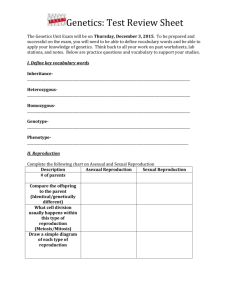Key Words & Concepts
advertisement

2nd Semester Exam - Study Guide Test Date: Friday, June 5th Cell Unit – Key words & Concepts Cells – the building blocks of life o Eukaryotic – cell with a nucleus (DNA/chromosomes contained inside) Somatic Cells – body cells (23 pairs of chromosomes = 46 total) Cell Division – The Cell Cycle o Interphase – preparation stage o Mitosis – PMAT (division of the nuclear material) Prophase – nuclear membrane dissolves; DNA condensing Metaphase – chromosomes line up in the middle of the cell Anaphase – chromosomes pull apart and move toward poles of the cell Telophase – DNA uncoils; new nuclear membranes form o Cytokinesis – division of the cell (cytoplasm) o Parent cell – original cell o Daughter cells – two new cells – identical to parent cell and each other Cancer – tumor – abnormal mass of cells – most caused by mutations to DNA Photosynthesis – leaves – cells – chloroplasts Stomata - structures that allow for gas exchange during photosynthesis Genetics / DNA Unit – Key words & Concepts Punnett Squares – tool used to predict inheritance of traits in offspring Probability – chance an event will occur Allele – one of the two possible forms of a trait Dominant – stronger form of a trait Recessive – weaker form of a trait Homozygous – two of the same alleles (form) for a trait Heterozygous – two different alleles (forms) for a trait Hybrids - heterozygous Purebred - homozygous Genotype – gene pairs (ex. HH, Hh, hh) Phenotype – physical appearance (ex. Widow’s peak or straight hairline) Pedigree – traits studied within a family line (ancestry) Generations – P1 = parents, F1 = first generation of offspring, F2 = second generation Human Chromosomes - 46 in somatic cells; 23 in sex cells Sex Chromosomes – Females (XX); Males (XY) DNA Bases – adenine, thymine, guanine, cytosine RNA Bases – adenine, uracil, guanine, cytosine Gene – controls the inheritance of a trait Gregor Mendel – Father of Genetics Watson & Crick – structure of DNA Rosalind Franklin – X-Ray diffraction Evolution Unit – Key words & Concepts Geologic Time Scale o History of life on earth using rock samples and fossils Relative dating o Fossil dating - using rock layers to determine which fossil samples are older or younger in relationship to one another Adaptation – increase an organisms ability to survive and reproduce Biodiversity – variation among species Sedimentary rock (sediment) – place where most fossils are formed Competition – struggle for survival Evolution – change within an organism over time Galapagos Islands – birth place of evolution/natural selection; Charles Darwin Ancestor – evolutionary relatives Ecology & Biodiversity – Key words & Concepts Pennsylvania – Deciduous Forest Biome o Warm summers & cold winters o Moderate yearly precipitation (50 cm) o Abundant biodiversity/habitats Forest Stratification – Levels of biodiversity o Emergent – tallest of the trees o Canopy – majority of tree crowns o Understory – saplings represent future of the forest o Forest floor – decomposition Clear-Cutting - removing all trees from an area at once o Habit destruction; population of species decline; erosion of soil Selective Cutting – removing mature trees to promote sapling growth o Sustainable Forestry – promoting renewability of natural resource o Benefits – produce oxygen, absorb pollutants, prevent soil erosion/flooding Ecological Succession – development of an ecosystem o Primary – small plants and vegetation colonize first Forest fires can activate seeds dormant in soil to release seeds o Secondary – larger plants develop and animals begin to inhabit the area Keystone Species – influence the survival of other organisms within an ecosystem Food Chain – predator/prey relationships Biodiversity – variety of life within an area Semester 2 Assessments DNA Unit Quiz – 35 points Genetics Quiz #1: Vocabulary & Principles of Genetics – 50 points Genetics Quiz #2: Punnett Squares & Probability – 42 points Evolution Open Note/Book Test – 35 points You can also use the online reviews from my teacher website as well as your current notebook on Evolution & Biodiversity. Lunch study sessions on Monday, June 1st and Wednesday, June 3rd.








